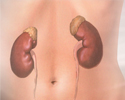Hemodialysis access procedures
Kidney failure - chronic - dialysis access; Renal failure - chronic - dialysis access; Chronic renal insufficiency - dialysis access; Chronic kidney failure - dialysis access; Chronic renal failure - dialysis accessVascular access (often called just "access") is needed for you to get hemodialysis. The access is where you receive hemodialysis. Using the access, blood is removed from your body, cleaned by the dialysis machine (called the dialyzer), and then returned to your body.
Hemodialysis
Dialysis treats end-stage kidney failure. It removes waste from your blood when your kidneys can no longer do their job. There are different types o...
Read Article Now Book Mark ArticleUsually the access is put in your arm but it can also go in your leg. It takes a few weeks to a few months to get an access ready for hemodialysis.
Description
A surgeon will put the access in. There are three types of accesses.
Fistula:
- The surgeon joins an artery and vein under the skin. That is why this is called an arterio-venous or A-V fistula.
- With the artery and vein connected, more blood flows into the vein. This makes the vein strong. Needle insertions into this strong vein are easier for hemodialysis.
- A fistula takes 1 to 4 weeks to become ready to use.
Graft:
- If you have small veins that cannot develop into a fistula, the surgeon connects an artery and vein with an artificial tube called a graft.
- Needle insertions can be done into the graft for hemodialysis.
- A graft takes 3 to 6 weeks to heal.
Central venous catheter:
- If you need hemodialysis right away and you do not have time to wait for a fistula or graft to become ready for use, the surgeon can put in a hemodialysis catheter.
- The catheter is put into a vein in the neck, chest, or upper leg.
- This catheter is temporary. It can be used for dialysis while you wait for a fistula or graft to heal.
Why the Procedure Is Performed
Kidneys act like filters to remove extra fluid and waste from your blood. When your kidneys stop working, hemodialysis can be used to clean your blood. Hemodialysis is usually done 3 times a week and takes about 3 to 4 hours.
Hemodialysis
Dialysis treats end-stage kidney failure. It removes harmful substances from the blood when the kidneys cannot. This article focuses on peritoneal d...
Read Article Now Book Mark ArticleRisks
With any type of access, you will have a risk of developing an infection or a blood clot. If infection or blood clots develop, you will need treatment or more surgery to fix it.
Before the Procedure
The surgeon decides the best place to put your vascular access. A good access needs good blood flow. Doppler ultrasound or venography tests may be done to check blood flow at a possible access site.
Vascular access is often done as a day procedure. You can go home afterwards. Ask your surgeon if you will need someone to drive you home.
Talk to your surgeon and anesthesiologist about anesthesia for the access procedure. There are two choices:
- You can receive medicine that makes you a little sleepy and local anesthetic to numb the site. Cloths are tented over the area so you do not have to watch the procedure.
- You can receive general anesthesia so you are asleep during the procedure.
After the Procedure
Here is what to expect:
- You will have some pain and swelling at the access right after surgery. Prop your arm up on pillows and keep your elbow straight to decrease swelling.
- Keep the incision dry. If you have a temporary catheter put in, do not get it wet. An A-V fistula or graft can get wet 24 to 48 hours after it is put in.
- Do not lift anything over 15 pounds (7 kilograms).
- Do not do anything strenuous with the limb with the access.
Contact your surgeon if you have any signs of infection:
- Pain, redness, or swelling
- Drainage or pus
- Fever over 101°F (38.3°C)
Outlook (Prognosis)
Taking care of your access will help you keep it as long as possible.
Taking care of your access
Vascular access (often called just "access") is needed for you to get hemodialysis. Using the access, blood is removed from your body, cleaned by a ...
Read Article Now Book Mark ArticleA fistula:
- Lasts for many years
- Has good blood flow
- Has less risk for infection or clotting
Your artery and vein heal after each needle stick for hemodialysis.
A graft does not last as long as a fistula. It can last 1 to 3 years with proper care. Holes from the needle insertions develop in the graft. A graft has more risk for infection or clotting than a fistula.
References
National Institute of Diabetes and Digestive and Kidney Diseases website. Hemodialysis. www.niddk.nih.gov/health-information/kidney-disease/kidney-failure/hemodialysis. Updated January 2018. Accessed September 11, 2023.
Yeun JY, Young B, Depner TA, Chin AA. Hemodialysis. In: Yu ASL, Chertow GM, Luyckx VA, Marsden PA, Skorecki K, Taal MW, eds. Brenner and Rector's The Kidney. 11th ed. Philadelphia, PA: Elsevier; 2020:chap 63.
Review Date: 8/28/2023
Reviewed By: Walead Latif, MD, Nephrologist and Clinical Associate Professor, Rutgers Medical School, Newark, NJ. Review provided by VeriMed Healthcare Network. Also reviewed by David C. Dugdale, MD, Medical Director, Brenda Conaway, Editorial Director, and the A.D.A.M. Editorial team.



